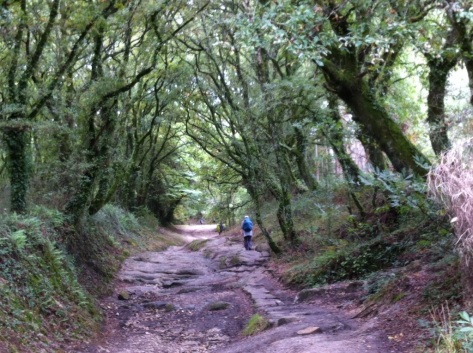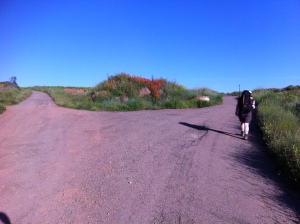Just over a year ago we celebrated the great feast of Pentecost at Trinity, Menlo Park. After nearly seven years of serving in the parish, I was moving on, and I was moved by the experience of saying good-bye to a place and community that I loved. At the same time, I was excited about going on vacation with my husband in France, and making our way to St. Jean Pied-de-Port, the jumping off point for my Pilgrimage on the Camino de Santiago. It was a beautiful leave-taking.
In the Episcopal Church—and in other denominations, too, I’m sure— there’s a tradition of blessing members and clergy on their last Sunday at the parish. As we were planning the Pentecost liturgy last spring, I found this Blessing of the Pilgrims online, and we personalized it for my last service:
Blessing of the Pilgrims
O God, who brought your servant Abraham out of the land of the Chaldeans, protecting him in his wanderings, who guided the Hebrew people across the desert, we ask that you watch over your servant Beth, who for the love of your name, walks to Santiago de Compostela.
Be her companion on the walk,
Her guide at the crossroads,
Her breath in her weariness,
Her protection in danger,
Her shelter on the Camino,
Her shade in the heat,
Her light in the darkness,
Her consolation in her discouragements,
And her strength in her intentions.
So that with your guidance she may arrive safe and sound at the end of the Road,
And, enriched with grace and virtue, return safely to her home, filled with joy.
In the name of Jesus Christ, our Lord, Amen.
Near the end of the liturgy, the dear people of Trinity encircled me, and the whole community was connected by the laying on of hands as I received the blessing. My heart was full, and overflowing with love. The Holy Spirit was there with us.
Two weeks later I walked the Camino over the Pyrennes to Roncevalles, the first stop in Spain. I went to the Pilgrim’s Mass at the 13th Century Royal Collegiate Church that night with several hundred of my new best Pilgrim friends from around the world.
At the end of the Pilgrim’s Mass, the priest blessed the gathered Pilgrims in Spanish—with the same blessing we’d used at Trinity on my last Sunday!
It was my first experience on the Camino of bawling my eyes out because something had touched me so deeply and so unexpectedly. I came to recognize these surprising experiences of joy as Holy Spirit moments. There were more to come.
It’s only in retrospect that I can now appreciate the power of that Blessing by the Trinity Community on Pentecost.
When I read the Blessing now, a year later, each phrase calls to mind a specific experience on the Camino where I felt God’s presence.
It marked a transition in my ministry, and the beginning of my Camino. In that moment, I received the grace and courage to become a Pilgrim, and to walk with a wholehearted sense of purpose: to learn to live into a new sense of joy, and a deeper faith.
What a blessing!
As we approach Pentecost 2014, I give thanks for my time at Trinity, for my colleagues there, and for all the people of the Trinity community. I give thanks for my year of discovery, on the Camino, and afterwards, and for a renewed sense of call.
I give thanks, too, for the gift of the Holy Spirit. She continues to blow through our lives with unexpected joys, filling us with her power. She leads us ever onwards, to new experiences, new connections, new life.







































